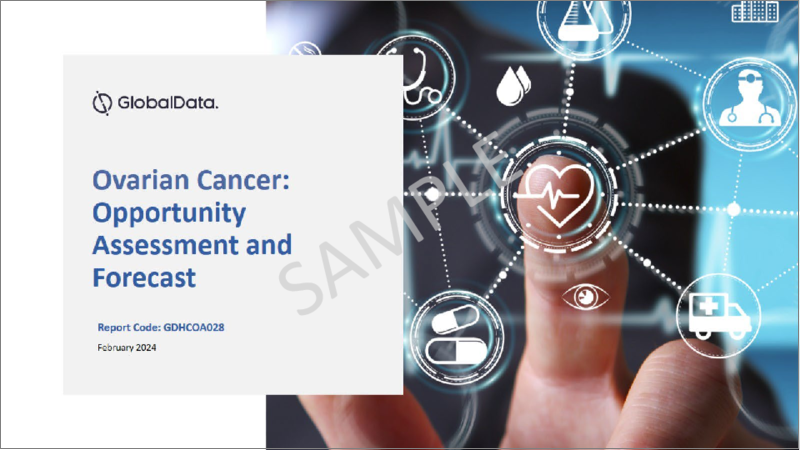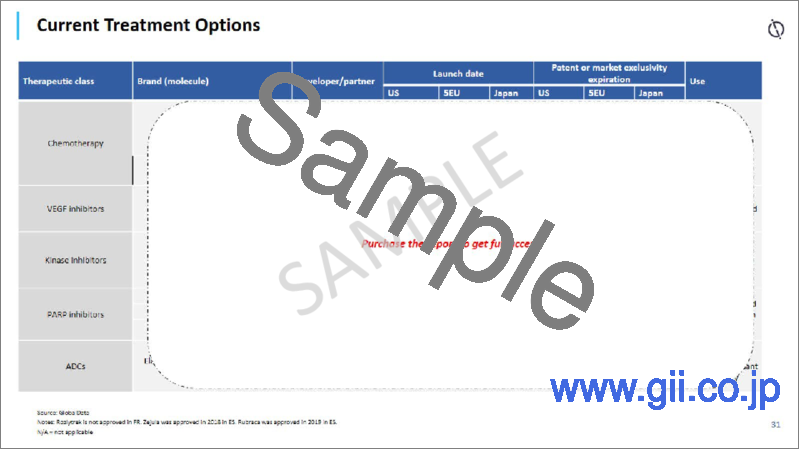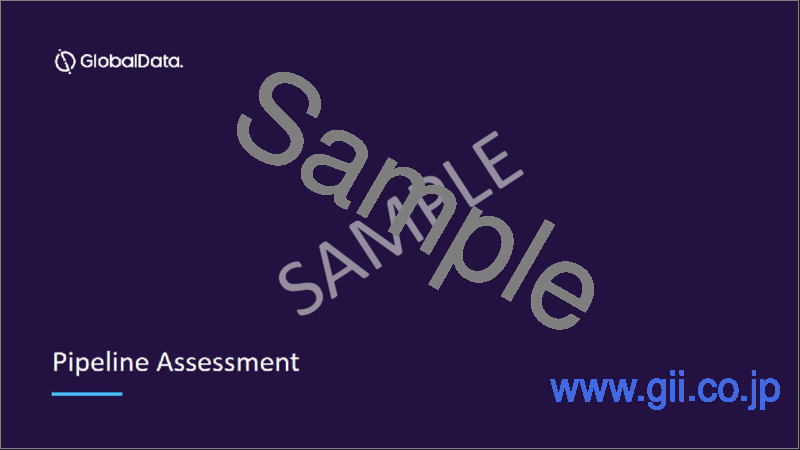|
|
市場調査レポート
商品コード
1458557
卵巣がんの機会評価と予測Ovarian Cancer Opportunity Assessment and Forecast |
||||||
|
● お客様のご希望に応じて、既存データの加工や未掲載情報(例:国別セグメント)の追加などの対応が可能です。 詳細はお問い合わせください。 |
|||||||
| 卵巣がんの機会評価と予測 |
|
出版日: 2024年02月08日
発行: GlobalData
ページ情報: 英文 79 Pages
納期: 即納可能
|
- 全表示
- 概要
- 目次
卵巣がんは、世界的に最も致死率の高い婦人科がんの1つです。希少がんであるにもかかわらず、卵巣がんはブロックバスター市場であり、2022年の売上高33億米ドルから2032年には41億米ドルに、CAGR2.0%で拡大すると予想されています。卵巣がん患者は一般にプラチナ製剤ベースの化学療法によく反応し、初回治療で完全寛解を達成します。しかし、残存病変のある患者の再発リスクは高いです。さらに、化学療法耐性の急速な出現が観察されます。現在、白金製剤抵抗性患者に対する標準治療は、単剤療法または標的治療薬(ベバシズマブ)もしくは細胞毒性薬剤(タキサン系薬剤、ゲムシタビン、ペグ化リポソームドキソルビシン、トポテカン)との併用療法による逐次的な非白金製剤治療です。卵巣がんには、患者の全生存期間を延長するためのフロントライン治療選択肢の改善や白金製剤抵抗性患者に対する代替選択肢を求めるアンメットニーズがいくつか存在します。
PARP阻害剤は、高い治療率を誇る維持療法の第一選択薬として確立しており、今後も第一選択薬としての市場シェアを維持すると予想されます。
当レポートでは、世界の卵巣がん治療薬市場について調査し、疾患の概要と疫学動向、治療法とアンメットニーズ、パイプライン動向などについてまとめています。
目次
第1章 序文
第2章 エグゼクティブサマリー
第3章 疾患の概要
第4章 疫学
- 卵巣がんと診断された症例、女性、年齢18歳以上、2022年~2032年
- 年齢別卵巣がん診断件数(女性、2022年)
- 組織学的サブタイプ別上皮性腫瘍の診断症例数、女性、年齢18歳以上、2022年
- FIGOステージ別卵巣がんの診断症例数、女性、年齢18歳以上、2022年
- 2022年、5年間の診断有病率、女性、年齢18歳以上
- 卵巣がんの診断事例の情報源と調査手法
- 情報源と調査手法
- 情報源と調査手法-卵巣がんの診断発生率
- 情報源と調査手法-5年間に診断された卵巣がんの有病率
- 情報源と調査手法-組織学的サブタイプ別上皮性腫瘍の診断症例
第5章 現在の治療オプション
- 卵巣がん治療アルゴリズム
- 治療パラダイム- 第一選択療法
- 治療パラダイム- プラチナステータス
- 現在の治療オプション
- VEGF阻害剤(アバスチン)の製品プロファイル
- PARP阻害剤の製品プロファイル(Lynparza、Rubraca、Zejula)
- キナーゼ阻害剤(ロズリートレック)の製品プロファイル
- 抗体薬物複合体(Elahere)の製品プロファイル
第6章 アンメットニーズと機会
第7章 研究開発戦略
- 卵巣がんの臨床試験デザインの動向
- 卵巣がんの取引動向
第8章 パイプライン評価
第9章 市場見通し
- 試験スポンサー別卵巣がん臨床試験
- 卵巣がん市場予測
- 市場促進要因と抑制要因
第10章 付録
第11章 お問い合わせ
This report includes an assessment of the disease epidemiology and 10-year patient-based forecast (PBF) across the 7MM for marketed and late-stage pipeline therapies, with a launch date assessment by market for Ovarian Cancer. These sales forecasts leverage data on pharmaceutical sales and drug availability from GlobalData's World Markets Healthcare (WMH) and POLI Price Intelligence databases.
Ovarian Cancer is one of the most lethal gynecological cancers worldwide. Despite being a rare cancer, ovarian cancer is a blockbuster market and is expected to grow from sales of $3.3 billion in 2022 to $4.1 billion in 2032 at a compound annual growth rate (CAGR) of 2.0%. Ovarian cancer patients generally respond well to platinum-based chemotherapy and achieve complete remission in the initial setting. However, the risk of recurrence for patients with residual disease is high. Additionally, the rapid emergence of chemotherapy resistance is observed. Currently, the standard treatment for platinum-resistant patients is sequential non-platinum treatment with either monotherapy or combination treatment with targeted therapy (bevacizumab) or cytotoxic agents (taxanes, gemcitabine, pegylated liposomal doxorubicin, or topotecan).There are several unmet needs in Ovarian Cancer that call for improved front-line treatment options and alternative options for platinum-resistant patients for extending overall survival in patients.
Major drivers of growth in the Ovarian Cancer market across the 7MM over the forecast period include the following:
- The sales of ImmunoGen's Elahere represent the most impactful driver of growth for the ovarian cancer market. Elahere is anticipated to launch in the 5EU and Japan during the forecast period.
- Combinations of PARP inhibitors, VEGF inhibitors, and ICIs are expected to launch in the 7MM during the forecast period.
- New drug launches for novel therapies will take considerable market share from generic chemotherapies.
- PARP inhibitors are established in the front-line maintenance setting with high treatment rates and are expected to retain their market share in the first-line setting.
chemotherapies.
Major barriers to growth in the Ovarian Cancer market across the 7MM over the forecast period include the following:
- High costs and issues with reimbursement associated with both front-line treatments and prospective novel therapies may reduce uptake and off-label usage.
- Voluntary withdrawals and generic erosion upon the patent expiries of the PARP inhibitors will temper sales growth during the forecast period in the ovarian cancer market.
This report covers the 7MM (US, France, Germany, Italy, Spain, UK, and Japan) and includes an assessment of the disease epidemiology and 10-year patient-based forecast (PBF) across the 7MM for marketed and late-stage pipeline therapies, with a launch date assessment by market for Ovarian Cancer.
These sales forecasts leverage data on pharmaceutical sales and drug availability from GlobalData's World Markets Healthcare (WMH) and POLI Price Intelligence databases.
Ovarian Cancer is one of the most lethal gynecological cancers worldwide. Despite being a rare cancer, ovarian cancer is a blockbuster market and is expected to grow from sales of $3.3 billion in 2022 to $4.1 billion in 2032 at a compound annual growth rate (CAGR) of 2.0%.
Key Highlights
- Report deliverables include a Pdf report and Excel-based forecast model
- Forecasts includes the 7MM
- Forecasts covers from 2022-2032
- GlobalData valued the Ovarian Cancer market in the 7MM at $3.3 billion and expects the market to increase to $4.1 billion by 2032
- ImmunoGen, AstraZeneca, Merck, and GSK are expected to take market-leading position in 2032
- A high level of unmet need will remain for most Ovarian Cancer patient populations during the forecast period
- The Ovarian Cancer late-stage R&D pipeline is widely varied with several novel therapeutic classes
Scope
Overview of Ovarian Cancer, including epidemiology, symptoms, diagnosis, and disease management.
Annualized Ovarian Cancer therapeutics market revenue, cost of therapy per patient, and treatment usage patterns forecast from 2022 to 2032.
Key topics covered include strategic competitor assessment, market characterization, unmet needs, clinical trial mapping, and implications of these factors for the Ovarian Cancer therapeutics market.
Pipeline analysis: comprehensive data assessing emerging trends and mechanisms of action under development for Ovarian Cancer treatment. The most promising candidates in Phase III and Phase IIb development are profiled.
Analysis of the current and future market competition in the global Ovarian Cancer therapeutics market. Insightful review of the key industry drivers, restraints and challenges. Each trend is independently researched to provide qualitative analysis of its implications
Reasons to Buy
Develop and design your in-licensing and out-licensing strategies through a review of pipeline products and technologies, and by identifying the companies with the most robust pipeline.
Develop business strategies by understanding the trends shaping and driving the global Ovarian Cancer therapeutics market.
Drive revenues by understanding the key trends, innovative products and technologies, market segments, and companies likely to impact the global Ovarian Cancer therapeutics market in the future.
Formulate effective sales and marketing strategies by understanding the competitive landscape and by analyzing the performance of various competitors.
Identify emerging players with potentially strong product portfolios and create effective counter-strategies to gain a competitive advantage.
Organize your sales and marketing efforts by identifying the market categories and segments that present maximum opportunities for consolidations, investments and strategic partnerships
Table of Contents
Table of Contents
1. Preface
- 1.1. Contents
- 1.2. Related Reports
- 1.3. Abbreviations
2. Executive Summary
3. Disease Overview
- 3.1. Overview of Ovarian Cancer
- 3.2. Ovarian Cancer Strengths, Weaknesses, Opportunities, and Threats Analysis
- 3.3. Classification of Ovarian Cancer
4. Epidemiology
- 4.1. Diagnosed Incident Cases of Ovarian Cancer, Women, Ages >=18 Years, 2022-32
- 4.2. Age-Specific Diagnosed Incident Cases of Ovarian Cancer, Women, 2022
- 4.3. Diagnosed Incident Cases of Epithelial Tumors by Histological Subtype, Women, Ages >=18 Years, 2022
- 4.4. Diagnosed Incident Cases of Ovarian Cancer by FIGO Stage, Women, Ages >=18 Years, 2022
- 4.5. Five-Year Diagnosed Prevalent Cases, Women, Ages >=18 Years, 2022
- 4.6. Sources and Methodology for Diagnosed Incident Cases of Ovarian Cancer
- 4.7. Sources and Methodology
- 4.8. Sources and Methodology - Diagnosed Incidence of Ovarian Cancer
- 4.9. Sources and Methodology - Five-Year Diagnosed Prevalent Cases of Ovarian Cancer
- 4.10. Sources and Methodology - Diagnosed Incident Cases of Epithelial Tumors by Histological Subtype
5. Current Treatment Options
- 5.1. Ovarian Cancer Treatment Algorithm
- 5.2. Treatment Paradigm - First-Line Therapy
- 5.3. Treatment Paradigm - Platinum-Status
- 5.4. Current Treatment Options
- 5.5. Product Profile of VEGF Inhibitor (Avastin)
- 5.6. Product Profiles of PARP Inhibitors (Lynparza, Rubraca, Zejula)
- 5.7. Product Profile of Kinase Inhibitor (Rozlytrek)
- 5.8. Product Profile of Antibody-Drug Conjugate (Elahere)
6. Unmet Needs and Opportunities
7. R&D Strategies
- 7.1. Trends in Ovarian Cancer Clinical Trial Design
- 7.2. Trends in Ovarian Cancer Deal-Making
8. Pipeline Assessment
- 8.1. Ovarian Cancer Pipeline Overview
- 8.2. Late-Stage Pipeline Agents for Ovarian Cancer
- 8.3. Product Profile of Verastem Oncology's avutometinib + defactinib
- 8.4. Product Profile of Zentalis Pharmaceuticals's azenosertib
- 8.5. Product Profile of Novartis's Femara (letrozole)
- 8.6. Product Profile of Alkermes's nemvaleukin
- 8.7. Product Profile of Corcept Therapeutics's relacorilant
- 8.8. Product Profile of Genelux's Olvi-vec (olvimulogene nanivacirepvec)
- 8.9. Product Profile of AstraZeneca's cediranib maleate
- 8.10. Product Profile of Advenchen Laboratories's catequentinib
- 8.11. Product Profile of AstraZeneca's Imfinzi (durvalumab)
- 8.12. Product Profile of Merck & Co's Keytruda (pembrolizumab)
- 8.13. Product Profile of Roche's Tecentriq (atezolizumab)
- 8.14. Product Profile of GSK's Jemperli (dostarlimab)
- 8.15. Product Profile of Bristol Myers Squibb / Ono Pharmaceuticals's Opdivo (nivolumab)
- 8.16. Product Profile of OncoQuest's oregovomab
- 8.17. Product Profile of Eisai / Bristol Myers Squibb's farletuzumab ecteribulin
- 8.18. Product Profile of Mersana Therapeutics's upifitamab rilsodotin
- 8.19. Product Profile of Sutro Biopharma's luveltamab tazevibulin
9. Market Outlook
- 9.1. Ovarian Cancer Clinical Trials by Trial Sponsors
- 9.2. Ovarian Cancer Market Forecast
- 9.3. Market Drivers and Barriers
10. Appendix
- 10.1. Primary Research - KOL Information
- 10.2. About the Authors




